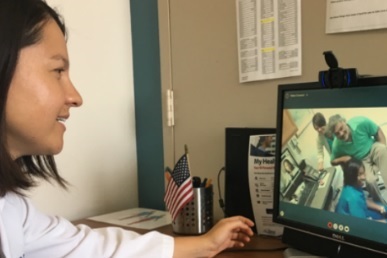Safe at Home: Virtual Visits
Ten things you maybe didn't know about video appointments
 There are over 36,000 VA Video Connect sessions a day across VA. If you didn't know about Telehealth before the spread of the coronavirus, there's a good chance you've heard of it by now. It makes a virtual appointment with your doctor safe and straightforward. Video appointments can be just as normal as in-person visits.
There are over 36,000 VA Video Connect sessions a day across VA. If you didn't know about Telehealth before the spread of the coronavirus, there's a good chance you've heard of it by now. It makes a virtual appointment with your doctor safe and straightforward. Video appointments can be just as normal as in-person visits.
VA Video Connect provides many of the same interactions you'd expect in a face-to-face visit. Here are a few things to consider doing in a video appointment:
Check your blood sugar correctly: If you're a diabetic patient, you can demonstrate to the doctor exactly how you check your blood sugar levels.
High blood pressure check: If hypertension is a concern, you can show your provider exactly how you use your blood pressure cuff at home.
Show some skin: With a clear video connection, you'll be able to show your doctor any rashes, swelling, bruises, or other skin conditions.
Demonstrate walking with a new cane: You can show your provider how you’re using it if you get a new cane. They'll want to see how well you balance on it. With help from a provider, video visits can help you improve your mobility.
Talk about your supplements: If you're worried about taking non-prescription like vitamins or other supplements, show your provider the active ingredients listed on the package during a video session to help them see the full picture of your medications.
Personalize your nutrition goals: Video visits enable a more personal, patient-centered dietary picture because you can show your dietitian your pantry, fridge, and kitchen setup.
Show your range of motion: Recovering from an injury can be stressful, but your therapist can be engaged with you each step of the way. Using movements recommended by your therapist or health care team, you can show your range of motion or level of pain over a video session.
Work with a speech therapist: Your therapist can see your verbal reactions and muscle movements in a video session better than in an audio phone call. You may also demonstrate swallowing difficulties using different kinds of solid foods and liquids to the therapist.
Connect with other Veterans online: With a group video, you can discuss challenges and find ways to overcome barriers with other Veterans in a therapist-led group session.
Save a trip for pre-op and post-op: If surgery is in your future, you may be able to have your pre-op and post-op appointments over the video if your doctor agrees.
Talk to your health care team about how you can use VA Video Connect. After completing a 'virtual' visit, you can view the doctor's notes and instructions in My HealtheVet. If you have questions, follow up with your health care team using Secure Messaging (sign in required). You'll receive a response within three business days.
If you don't use Wi-Fi or a broadband connection, but use a smartphone with a data plan, remember that many phone networks won't charge Veterans for using VA Video Connect.
Please vote in our unscientific poll. All responses are anonymous.
Read More
Need a Device or Internet Connection for VA Telehealth? (VAntage Point)
VA Video Connect Troubleshooting Tips (YouTube)
VA Video Connect App (VA Mobile)
Updated June 10, 2021

